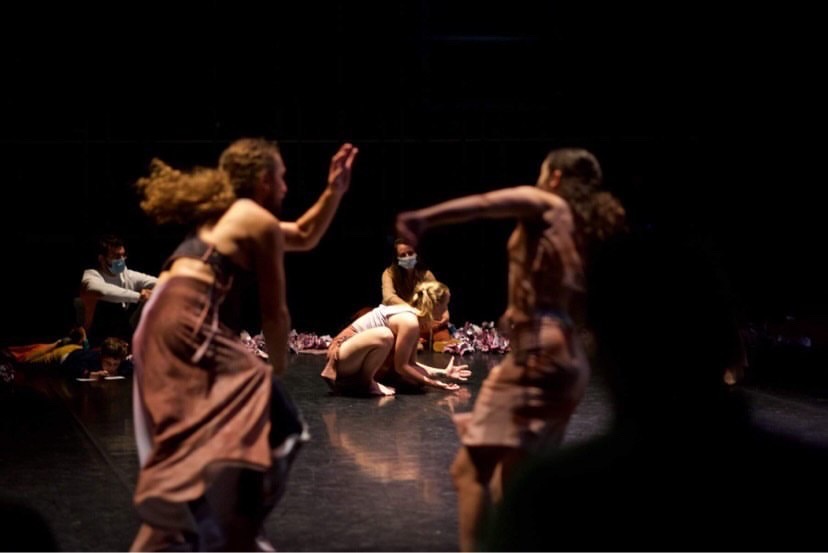Words by Katie Hagan.
I’ve been closely following the work of German dance artist and choreographer Greta Gauhe for just over a year now. I interviewed the UK-based dancer last year and around the same time I wrote about her work ‘NOWhere’ and ‘1 Click Away’ which debuted at Chisenhale Dance Space and The Place respectively, and featured Gauhe’s collaborators Hannah Adams and Flavien Cornilleau. Although I think it is important to take each work as its own and avoid assigning any arbitrary characteristics to what is an ever-changing body of dance, I can say I’ve noticed Greta creates immersive performances that flirt with audience participation; work that through this type of interaction brings us back to our childlike disposition to play.
Greta has said she works with dancers-cum-collaborators and encourages them to ‘deal’ with their own feelings during the making and performance processes. Depending on the socio-political context in which Greta’s work applies to, this fearlessness adds a deep honesty to the movement that is engendered – the dancers aren’t skating on the surface, they spill their souls onto the stage.
Greta’s latest work ‘Memories of Skin’ is no exception here. Exploring touch in the time of social distancing, ‘Memories of Skin’ is an eulogic lament of dance-making as we knew it before the pandemic wreaked havoc on the world.
As we enter the Laban Theatre, we each wait to be called in through the stage left door. We are led by a dancer through to a space similar to the room you’d watch a video in at a gallery; it feels like a secret, an underground zone away from the monotony outside. Pieces of paper rolled up as rocks have been ritualistically placed in a crescent, it’s the image of a pagan rite, an offering to us the new community. We sit far apart on bean bags and are invited to harvest the rocks of paper and write our thoughts in response to the question written on the page: How did it feel to experience touch again after so long? Warm, relieving, unsettling I write, contemplating what’s passed. During a pandemic where entire populations are being told to ‘move’ in the same way within the confines of government guidance, the refreshing framework of ‘Memories of Skin’ enabled us to follow our individual creative impulses within this Covid-secure space.
As none of the four dancers – Hannah Adams, Flavien Cornilleau, Natalie Sloth Ritcher and Johanna Merceron – can touch, Andy Trewren’s soundscape adds sensuality and friction to the environment. Rough papers rub against each other, human fingers tickle the water, its laughter evident in the self-generating jacuzzi spools that bubble in my mind’s eye. The sound and projected screen which layers images of the human body, together with the dancers’ purple/nudey costumes, cleverly conjure a closeness which we can’t have outside of this performance space.
The audience sit enveloping the dancers who move into the half-lunar performance space and start to direct each other’s movement verbally. They feel the weight of one another’s bodies even though they are at a distance, navigating physical interaction through words that are spoken. The dancers turn and use this process on us. My hand is drooping slightly over my left knee as I sit cross-legged, and the dancer says she is going to take it. She then experiments with what it would feel like to touch; the detail and attention here is so powerful I actually feel like a phantom is brushing against my twitchy fingers. I watched others at the same time, noticing that this sensory experience worked better when done in smaller iterations. Other more ambitious and forthright moves such as one dancer asking if they could rest their head in-between mine and my partner’s didn’t have the same uncanny and gentle effect as subtler interactions.

After experimenting with various kinds of ‘meetings’ each to different endings and effects, two dancers were left within the crescent. Again, they use words to instruct each other how to move, and there is palpable synergy and connection between the two even though they are apart. One exits in order to tease this gap further, continuing to use words to guide the dancer’s bodily musings. At this point however, and after so many words, it felt better for the dancer to be moving in silence and abandon verbal cues and signs just for Memories of Skin’s savourable final moment. It would have really added to the power of what is not said and its influence on the body aflamed by movement in front of us. In an aeon where movement is lamentably marginalised, this moment could have gone deeper.
Memories of Skin is in many ways a response to our unfortunate, lived reality. Yet in a time of social restrictions, Gauhe was highly inventive in her selection of performance environment and degree of audience participation, engaging us in a way I had certainly longed for. You will be moved by Memories of Skin both in a physical and figurative sense and I have to say after an absence from dance for over half a year, I found true solace in remembering and then experiencing again what it is like to touch those we wish we could but currently cannot.
Header image: Dominic Farlam.
Dancers: Hannah Adams, Flavien Cornilleau, Natalie Sloth Ritcher, Johanna Merceron. Film concept: Emily Romain. Composer: Andy Trewren. Choreographer: Greta Gauhe. Thanks to Marta Stepien.
